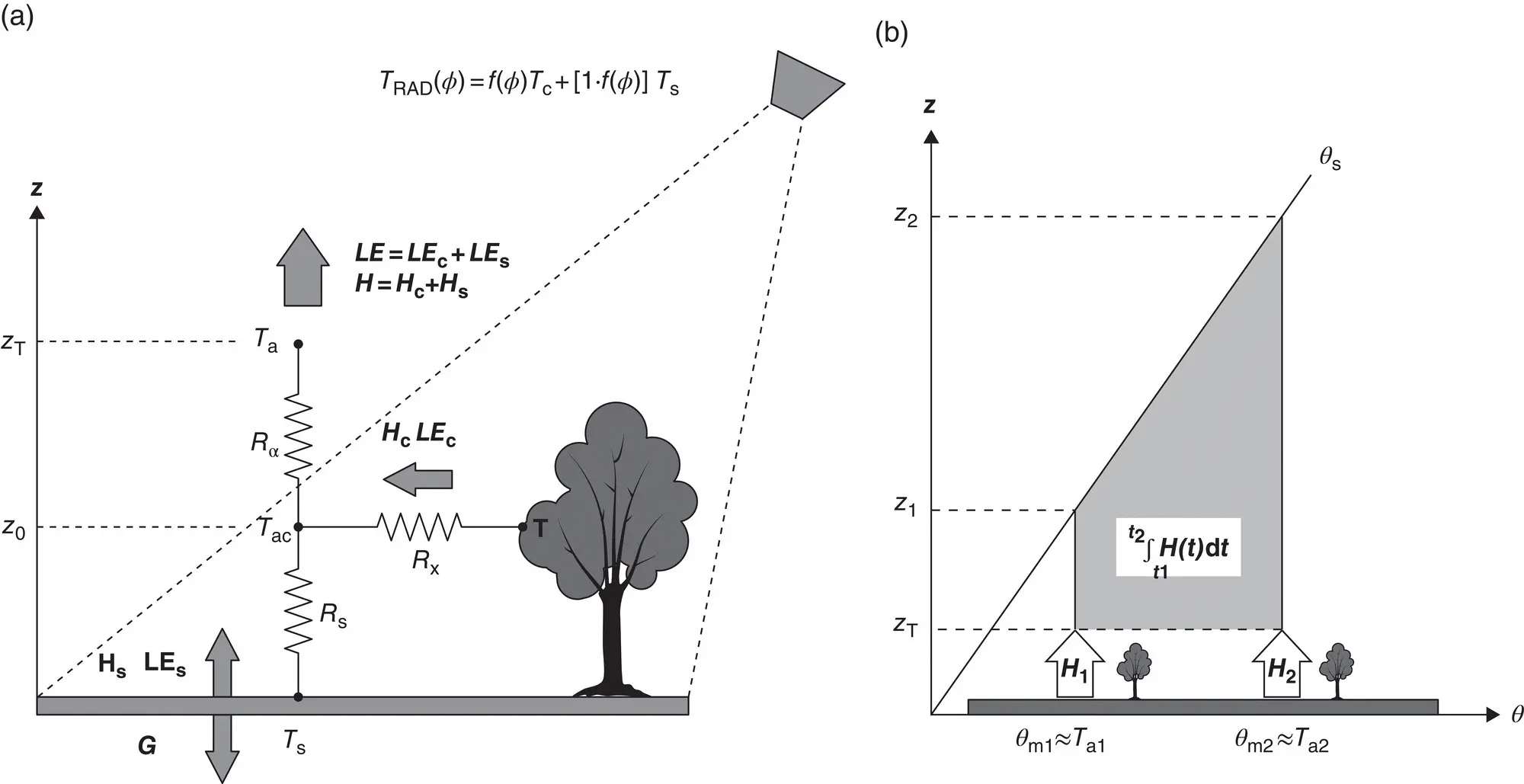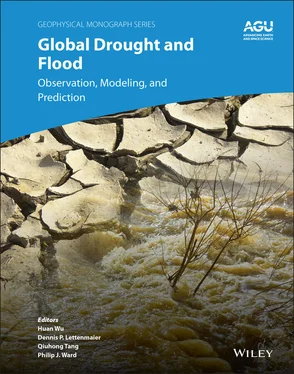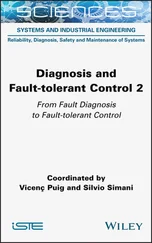(2.2) 
The net balance of energy at the Earth’s surface can be represented by
(2.3) 
where R nis the net radiation above the vegetated surface, and H , LE , and G are the net fluxes of sensible, latent, and ground conduction heating, respectively.
Using brightness temperature measurements at times t 1and t 2, and initial estimates of near‐surface temperature, the surface component of the ALEXI model yields instantaneous sensible heat flux estimates, H 1and H 2(Anderson et al., 1997). Assuming a linear rise in sensible heat during the morning hours, which has been found to be valid when advection is negligible, a time‐integrated heat flux can be computed by

Figure 2.1 (a) A schematic description of the surface‐layer component of the ALEXI model. (b) The surface‐layer model component is applied at times t 1and t 2during the morning hours, returning instantaneous sensible heat flux estimates. The time‐integrated sensible heat flux during this interval serves to heat and grow the atmospheric boundary layer.
(Source: From Mecikalski, J. M., G. R. Diak, M. C. Anderson & J. M. Norman (1999). Estimating fluxes on continental scales using remotely sensed data in an atmosphere–land exchange model. Journal of Applied Meteorology, 38, 1352–1369. © American Meteorological Society.)
(2.4) 
The ABL component of ALEXI is a simple slab model which describes the dynamics of the atmospheric boundary layer and is used as a closure technique to evaluate the morning evolution of air temperature, Ta, in the surface layer. It is assumed that all the air within the mixed layer is at a uniform potential temperature, and this value is related to the surface air temperature by
(2.5) 
where p is the atmospheric pressure (in kPa) at the surface and R / c p= 0.286 (Anderson et al., 1997). Tennekes (1973) showed that the height of the convective boundary layer at any time is uniquely defined by the current surface air temperature and a morning temperature sounding. McNaughton and Spriggs (1986) presented a simplified conservation equation describing the growth of a convective boundary layer over time, assuming no subsidence and horizontal advection:
(2.6) 
where θ m,1is the potential temperature within the mixed layer and θ s( z ) is the potential temperature profile above the mixed layer at time t 1. The time‐integrated sensible heat flux from the ABL component of the ALEXI model is computed given a value of θ m,2. Because differential surface temperature measurements are more reliable than absolute temperature measurements, in practice z 1is fixed at some small value (~50 m), and the change in modeled θ mis allowed to govern the growth of the boundary layer based on the lapse rate profile above the mixed layer height, z 1(Anderson et al., 1997). The sensible heat flux estimates from both the surface and ABL components of the ALEXI model are iterated until the time‐integrated sensible heat flux estimates from both components converge (Anderson et al., 1997). Based on the computation of sensible heat flux for the soil ( H S) and the canopy ( H C), the canopy transpiration ( LE C), the ground heat flux ( G ), and net radiation ( R n), the value for direct soil evaporation ( LE S) is solved as a residual to the surface energy budget calculation. Under drier conditions this can result in a direct soil evaporation of less than zero, which in unlikely during the midday period. This condition implies that the earlier assumption of the canopy transpiring at its potential rate is invalid, and in this case the canopy transpiration term is scaled back until the direct soil evaporation term is zero (Anderson et al., 1997). A number of primary data sources are needed for regional implementation of the ALEXI model and these data sources are summarized in Table 2.1.
Table 2.1 Major inputs data for GET‐D system
| Data source |
Specifications |
Resolution |
Format |
Example file names |
Size (MB) |
| GOES East and West |
Band 02 |
4 km |
McIDAS |
1350954623.goes13.2014.001.061520.BAND_02 |
~25 |
| GOES East and West |
Band 04 |
4 km |
McIDAS |
1350954623.goes13.2014.001.061520.BAND_04 |
~25 |
| GSIP |
L2 product |
4 km |
NetCDF |
gsipL2_goes13_GENHEM_2014198_1145.nc.gz gsipL2_goes15_GWNHEM_2014198_1400.nc.gz |
~20–30 |
| VIIRS |
Global NDVI and EVI |
375 m |
HDF5 |
GVF‐ASEVI‐P2_s20120726_e20120801_h00v01.h5 |
~800 |
| IMS |
Daily Northern Hemisphere Snow and Ice Analysis |
24 km |
ASCII |
ims2014017_24km.asc |
~1 |
2.3.2. Extrapolation from Instantaneous to Hourly and Daily Fluxes
A common technique for extrapolating instantaneous satellite‐based flux estimates to daily totals is to assume that the evaporative fraction ( EF ), given by the ratio of latent heat to the available energy, is constant during daylight hours for a given day (Gurney & Hsu, 1990; Shuttleworth et al., 1989; Sugita & Brutsaert, 1991). Given the value of EF determined at the ALEXI modeling time ( t 2) along with hourly estimates of R nand G at times t i, which can be obtained from GOES, hourly values of system sensible and latent heating can be computed for days with clear mornings as (Anderson et al., 1997):
(2.7) 
(2.8) 
Previous studies have shown that daily total fluxes estimated using the EF measured at midday underestimate observed totals by 5–10% (Brutsaert & Sugita, 1992; Crago, 1996; Gurney & Hsu, 1990; Sugita & Brutsaert, 1991; Zhang & Lemeur, 1995), therefore EF is defined here as:
(2.9) 
using flux components computed at modeling time t 2.
For clear pixels, hourly fluxes from the soil component of the two‐source system are obtained as:
Читать дальше





















